
Magazine Ratings
Location: Oakleigh South, VIC
Established: 1926
Architect: Sam Bennett (1926) / Sloan Morpeth (1938)/ Devin Hartley (1994)
First Played: 4th April 2014
Last Played: January 2017

31 (Current)

32 (Current)
Getting an invite to catch up with an old golfing buddy, Joe, along with playing one of the esteemed Top 100 Golf courses on the Melbourne Sandbelt, Commonwealth Golf Club, was an opportunity not to be missed.
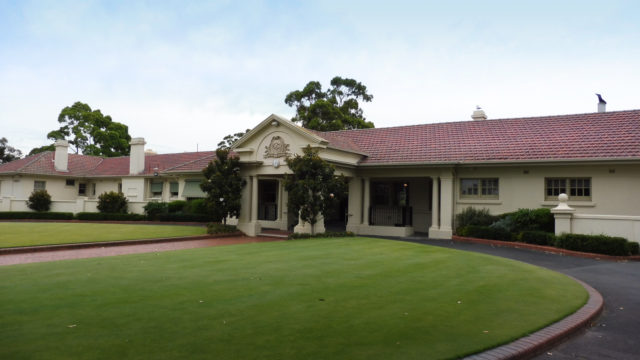
Clubhouse at Commonwealth Golf Club
First visiting Commonwealth Golf Club in 2014, I managed to forget an essential tool in documenting my journey, the camera. There was the phone camera, but I don’t really like the images especially in overcast conditions. So the write up on the visit was put on hold. Luckily an opportunity arose to revisit, which was the start of a month revisiting Sandbelt courses.
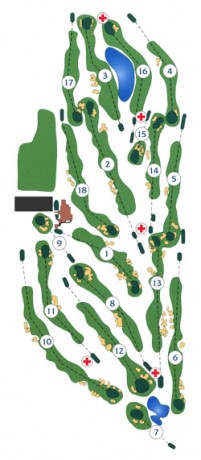
Commonwealth Golf Club Map
The course sits on a fairly narrow stretch of land, but is quite long, running in a mainly north south direction.
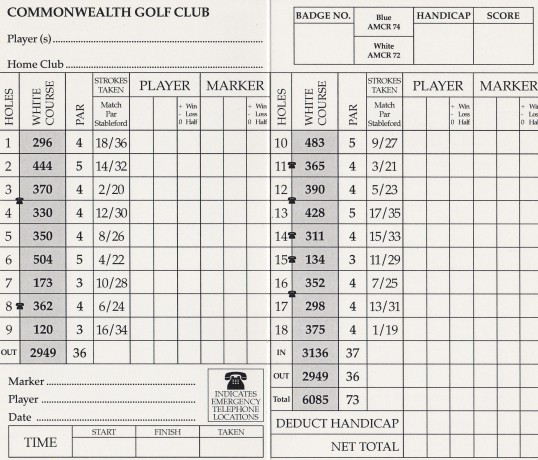
Scorecard for Commonwealth Golf Club
Play on both visits have been from the white tees. On the second visit (which these photos are from) play started on the 10th tee.
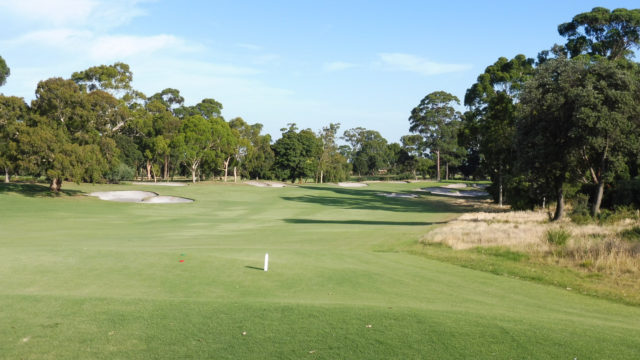
Hole 1 – 296 meter par 4
To start the round is the shortest par 4 and easiest hole at Commonwealth Golf Club. It also has potential to be one of the good holes on the course, offering a bit of risk vs reward. From the elevated tee, there is the potential to land up near, if not on the green. But the closer you get, the higher the danger.
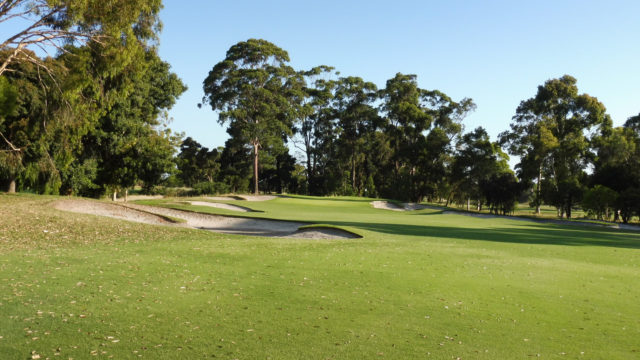
Approach from the 1st fairway
Of course there is the option to layup to a very wide fairway avoiding all the fairway traps. Playing to the left portion, leaves a longer shot opening up the green, but also has some risk with traps on the side of the fairway.
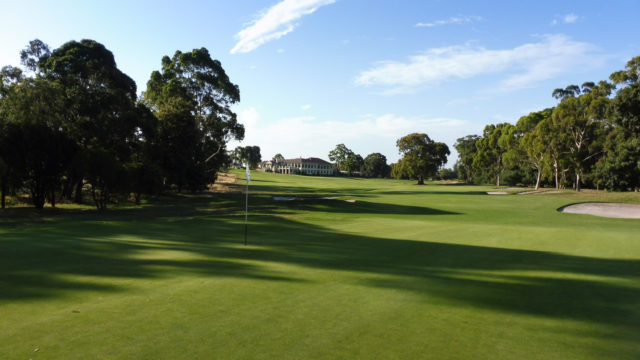
Looking back to the clubhouse from the 1st green
The putting surface, angling away to the right, is quite long. Sloping predominantly from rear to front, we find the bunker lips sit slightly higher on each side. So the one thing that stands out is bunkering all over the place and on both sides of the fairway. On my last visit I watched a lot of groups, with some very good players, with most laying up short of the first bunkers. Why? The risk wasn’t worth the potential reward of carrying them. With a green fairly receptive and shaped to take an approach from most areas of the fairway, it wasn’t really worth it. The trees on the inside of the turn and heavy under bush didn’t help either.
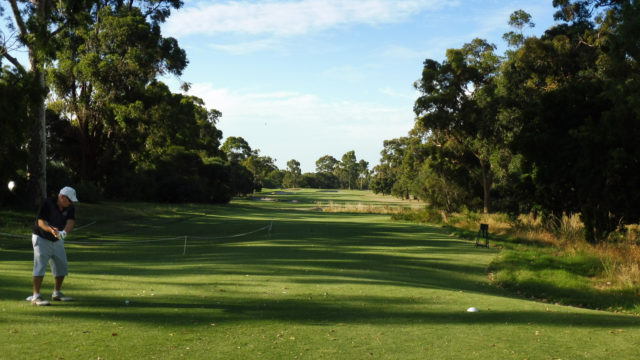
Hole 2 – 444 meter par 5 – Joe playing tee shot
Surprisingly this is not the shortest par 5 hole on the course, even though it measures 444 meters. Playing relatively straight up a tree lined fairway, traps are located to the left, forcing most players to the opposite side. Plenty of room out there but not the ideal line for those wanting to reach the green in two.
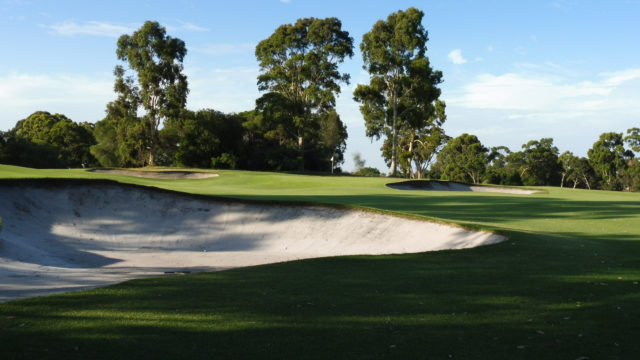
Approach from the 2nd fairway
With the second shot, some will be tempted to attack the green, whilst shorter hitters will be faced with a choice on where to layup. A bunker on the left around fifty meters short, sits on the ideal line into the green. It’s just a case of whether to play short of this or find the open space beyond.
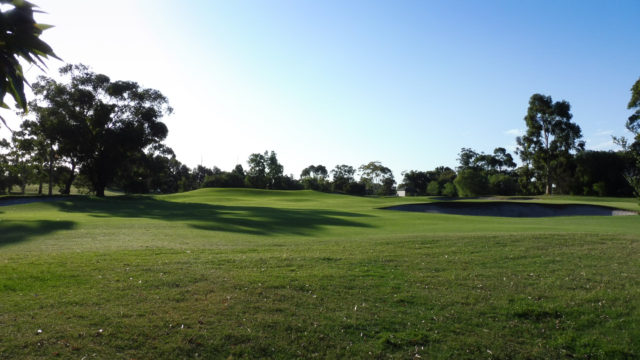
The 2nd (foreground) & 17th greens
Sitting slightly elevated above the fairway, the putting surface does run down to met the short surrounds. This leaves a false front and side to repel the ball, but also leaves a lot of options to play shots. The pear shaped green has a long bunker down the right, which really comes into play for those on the right portion of the fairway. The hole doesn’t look much, but shows some real strategic merit. Questions are asked on every shot, but if taking the hole on, rewards can be made.
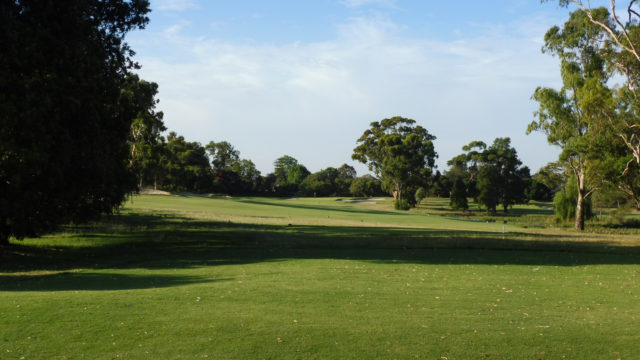
Hole 3 – 370 meter par 4
On this mid-long par 4, water comes into play down the right of the fairway. Only one of two holes, where you may get wet, the fairway slopes dramatically towards this direction.
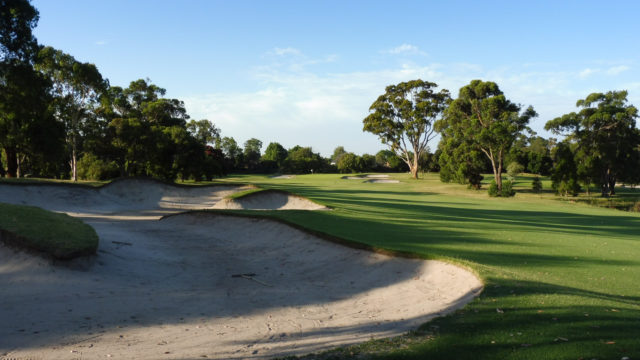
Bunkering along the 3rd fairway
Two bunkers run along the top of a hill to the left, which offers the best side to make the approach. Hitting up this side may gain extra distance with some roll of the hill.
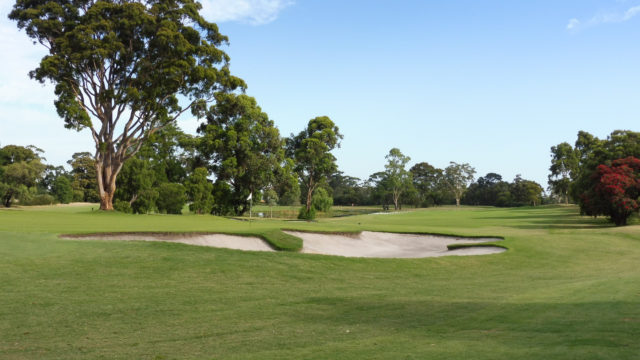
Looking back from the 3rd green
This longer green is well protected either side by large traps. Sloping mainly right to left, will make it harder for shots to hold the green if approaching from the right. That and the fact larger trees may come into play down that side. Ample room is found around the green to miss, but to the sides are not the best option. Interesting hole with water in play, unusual for a sandbelt course.
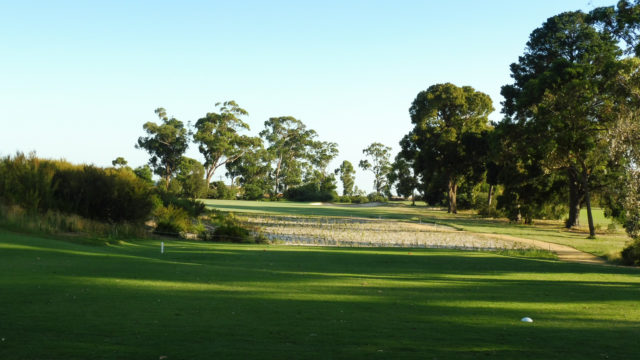
Hole 4 – 330 meter par 4
A short-mid par 4 follows playing with a dogleg to the right. Some exposed sandy waste is found just in front of the tee, one unique identifier with courses in this region. Play is over a slight hill with bunkers to the right. A wide fairway is found short of these, but narrows significantly beyond. Carrying the bunker is possible, but also opens the possibility of running through the fairway.
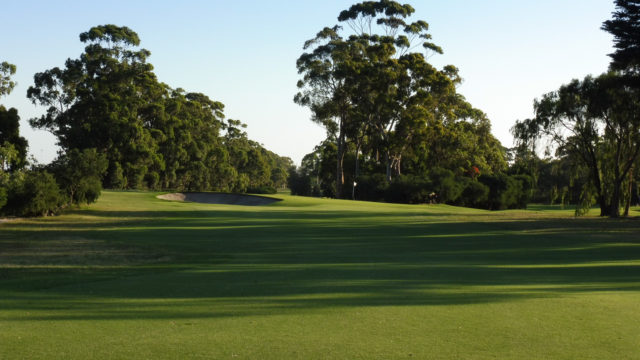
View from the 4th fairway
Approaching from the right hand side is the best option to this green. A large green side bunker is located to the left, leaving a tricky approach with the putting surface sloping left to right. Trying to run the ball into the green is difficult with a large swale found beside the left bunker, ready to collect the ball. Good strategic hole, where finding the best line requires a bit of risk, but will potentially reward.
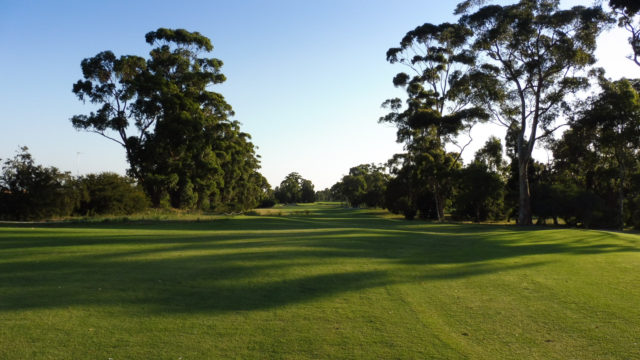
Hole 5 – 350 meter par 4
Heading along the eastern boundary is this mid length par 4. Playing relatively straight from an elevated tee, the fairway is not the widest, but runs slightly away. Out of bounds is down the left, with one fairway trap located to the right. This side also offers the best line into the green. Do you take on the risk for the reward?
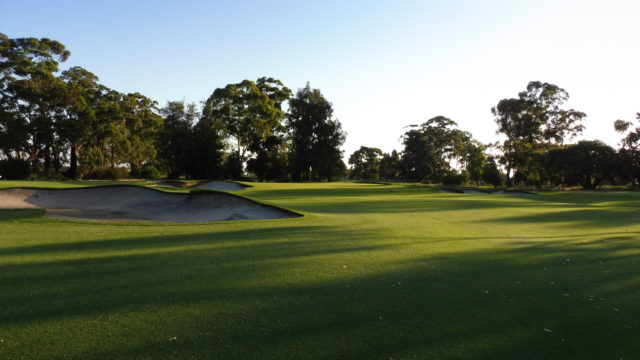
Approach to the 5th green
One fairway trap sits deceptively short of the green complex, but has a small amount of area beyond, before we get to the main attraction. Slightly raised, this green has bunkers on both sides, with one of the right side being shared with the 13th green. The putting surface has a strong slope from mid way back to the front, whilst the rear portion slopes away. Considering the hole is relatively straight, it offers a lot more than it looks, having some strategy which is simple yet effective.
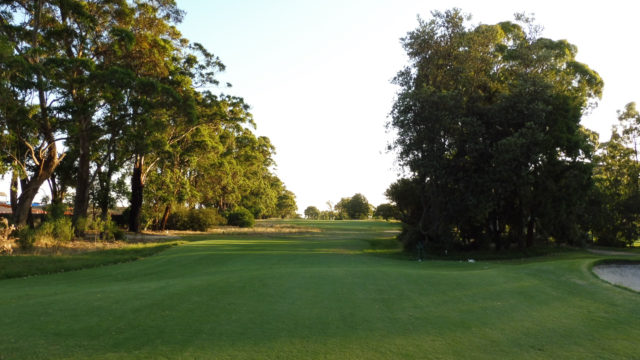
Hole 6 – 504 meter par 5
Reaching the longest hole and hardest par 5 at Commonwealth Golf Club, play continues down the eastern boundary. From the tee a small rise in the fairway, leaves some doubt with a partially blind shot. Out of bounds continues down the left, whilst a solitary trap is found on the right near the rise. There is no preferred area to land, just not in the bunker or too far to either side of the fairway.
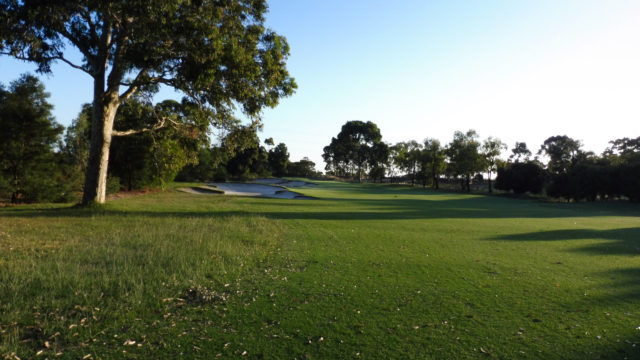
Looking down the 6th fairway
Playing the second requires finding the right side of the fairway, opening up the line into the green, but also avoiding the traps out to the left. The putting surface is much higher than the fairway, sloping left to right, but also back to front. Anything short may roll back down of the green front. Wasn’t a hole I had the highest regard for, although the green complex was good.
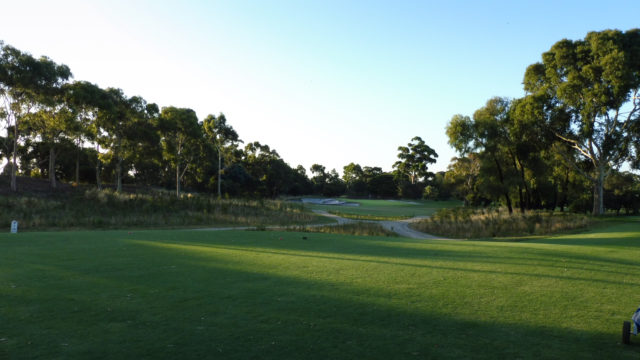
Hole 7 – 173 meter par 3
From the most difficult three shot hole to the longest and hardest par 3. Playing down hill from an elevated tee, a small carry is required over heathland. The green is a decent size, but two large bunkers cover the whole left side. Another sits to the rear, but it is the front two that really catch your attention.
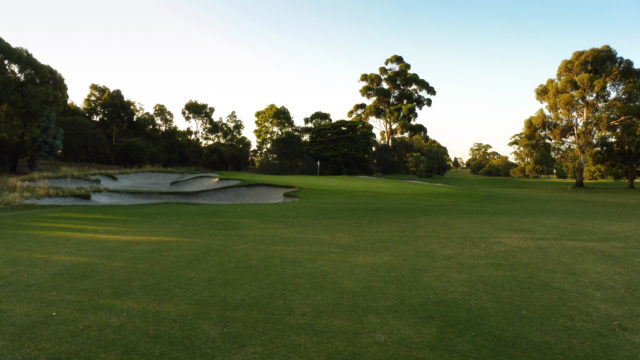
Large bunkers beside the 7th green
With a putting surface sloping predominantly left to right, but some back to front, there is ample room to find the green on the right side, which allows plenty of room to miss as well. One feature that is quite good on the hole, but some would ignore. Tough hole to start the run in which deserves a bit of respect.
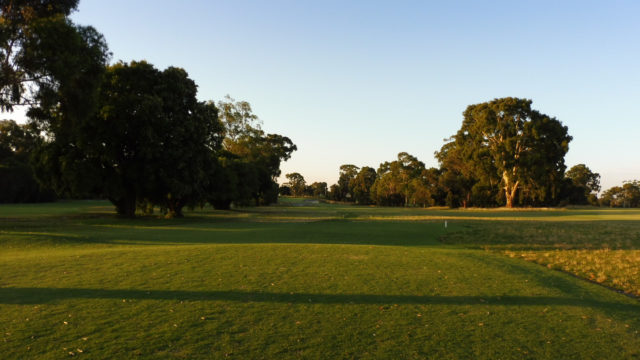
Hole 8 – 362 meter par 4
A medium length par 4 takes us back towards the clubhouse, with a slight turn to the left. A large bunker sits to the left, which if either carrying or playing a right to left shot, will find the ideal side for an approach to the green. There has been one controversial change where the 8th and 13th tee sit very close, in fact the 8th sits in front almost, leaving those on the 13th to wait until the tee clears. This has opened the line a lot more for the 8th but does cause issues when those on the 8th tee don’t observe the local rule where the 13th tee has right of way.
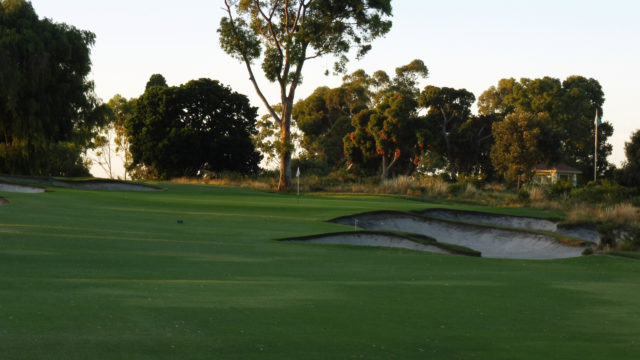
View up to the 8th green
A large gap into the elevated green is available for those left of the fairway, to avoid bunkers either side. These are large and cavernous on the right, so can be intimidating for those not confident in the sand. Finding those on the left is more of an issue, with the green sloping away to the deeper bunkers on the other side. Enjoyable hole with some strategy requiring though on where to land the ball, which could punish when finding the wrong section of the fairway or green.
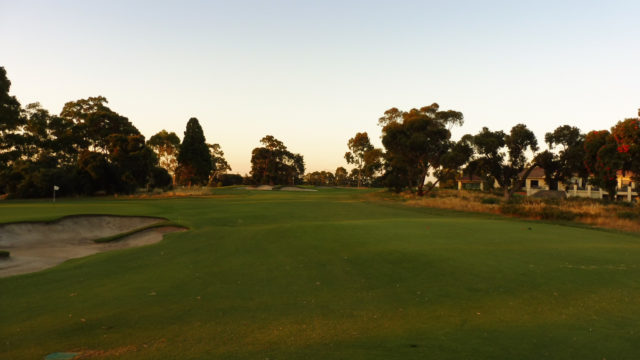
Hole 9 – 120 meter par 3
Finishing the front loop is the shortest and easiest par 3 at Commonwealth Golf Club. Even though short, wind can come into play as this is the highest point of the course. There is plenty of room to miss short of the green but front pin positions then become difficult.
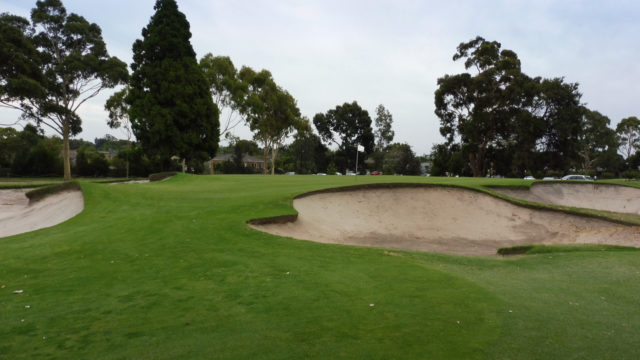
Bunkering beside the 9th green
Bunkers cover the front and right side of the green, whilst the left slopes away strongly, leaving a difficult shot back. The putting surface has various slopes to contend with so no guaranteed two putts here. Testing little hole showing length is not always necessary to have a successful hole.
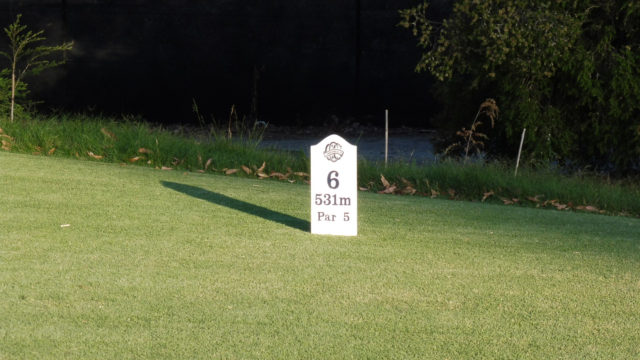
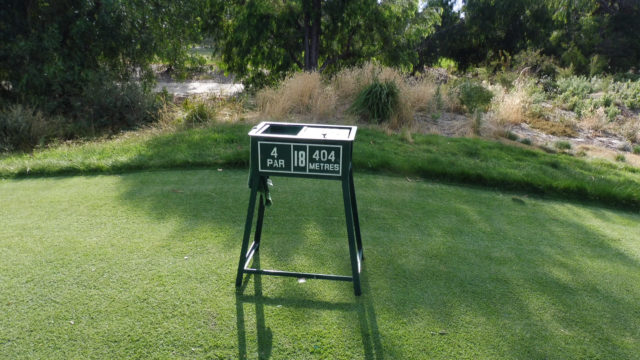
Hole marker and pin flag
The club has the standard type of hole markers, with hole number distance and par. Flags on the day were for a sponsored event, so unsure if these include the clubs logo. Portable rubbish bin and sand box are found on each tee, which also contains the same details as the hole markers.
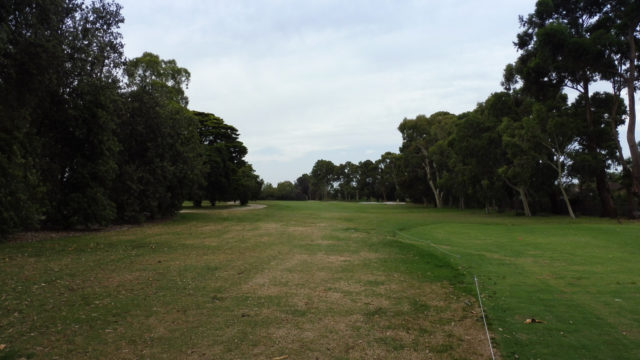
Hole 10 – 483 meter par 5
Starting the back loop is a longer par 5 hole which plays with a dogleg to the left. The course boundary runs along the right hand side where you find out of bounds. On the outside of the turn are two bunkers, which I assume is to encourage play to the left, the natural side to play anyway as this can shorten the hole if long enough.
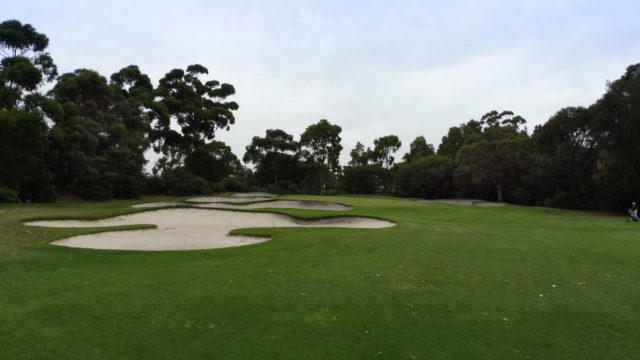
Approaching the 10th green
If long enough, the green can be reached in two, but for most it will be a case of playing to a spot for the third shot. Space is available on the right side of the fairway, avoiding the bunkers to the left and leaving a clear line to the green. There are some oddities on the hole which make this not the best hole. Besides the setup on the tee, there is just short of the green are two bunkers on the right, with a protruding tree between. Makes an impossible shot from the first and restricts balls hitting the second trap. Widely criticised design and weakest designed hole on the course.
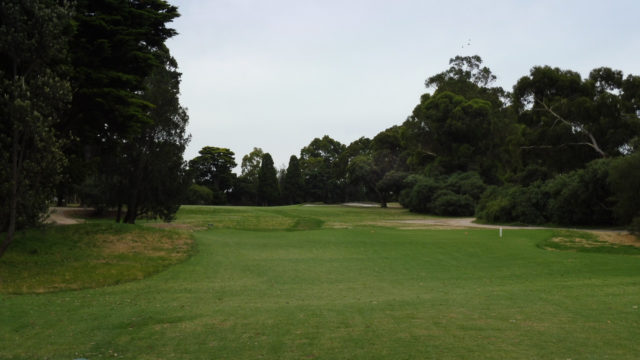
Hole 11 – 364 meter par 4
Heading back in the opposite direction is this mid length par 4 which turns to the right. From the tee the fairway falls away slightly before the turn, where a group of bunkers sit on the inside of the turn. There is quite a bit of width to land the ball before the turn, but this narrows beyond.
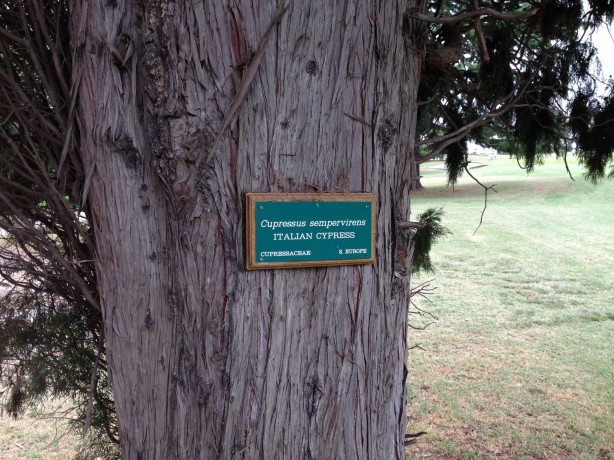
Love of trees on the course – Cypress on the 11th
The club is proud of the trees on the course and there are many varieties. This love affair is something it has battled with during the approved master plan. Part way through implementation it was stopped, then modified to stop the reduction in trees.
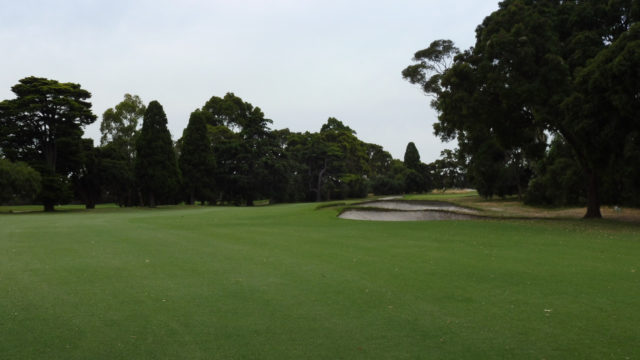
Dogleg on the 11th fairway
Longer hitters have the possibility of playing through the fairway, finding rough or trees beyond.
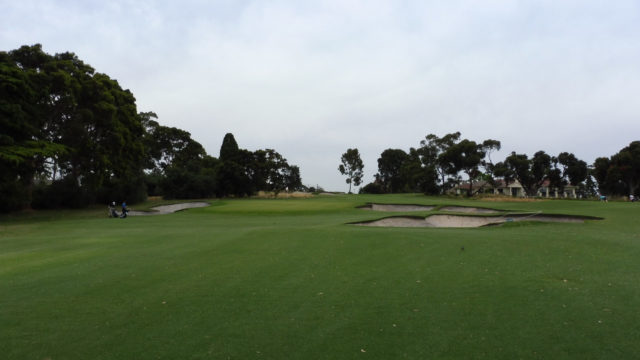
Approach to the 11th green
Making a shot from the left portion of the fairway leaves an open shot into the green, as this takes the fairway bunker just short, out of play. Providing some open space to the right, due to the adjoining tee takes away the constricted feeling sometimes felt on the tree lined course. But this is more appearance as you shouldn’t end up out that far. The green is slightly raised sloping mainly from the rear but also to the left, potentially providing a lot of action out of the left side bunker. Nice hole giving some options on strategy with every shot.
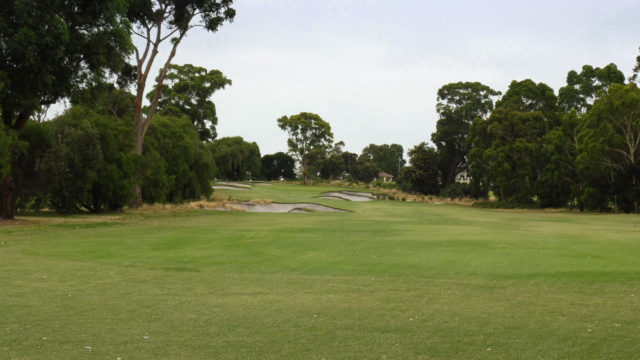
Hole 12 – 390 meter par 4
Playing back in the opposite direction is this longer par 4 which has a very slight turn to the right. From the elevated tee the entire hole is visible, warts and all. With a fairway sloping left to right, two bunkers are in play from the tee. One running length ways on the right, whilst a cross bunker to the left is found further along. The ideal line is down the right side, so I don’t understand the purpose of the cross bunker, as this is not the side to play.
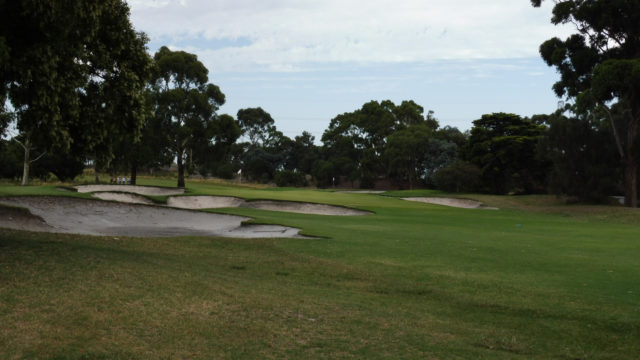
Bunkers around the 12th green
Another bunker is found short of the green on the right. Not really in play as the ideal side is still to the left. For those that might not reach the green, the left is the side to layup. Three further traps surround the putting surface, which slopes from the rear. Confusing hole due to placement of hazards, which do not add to any strategy, other than avoid the sand, causes this to be one of the least interesting holes on the course.
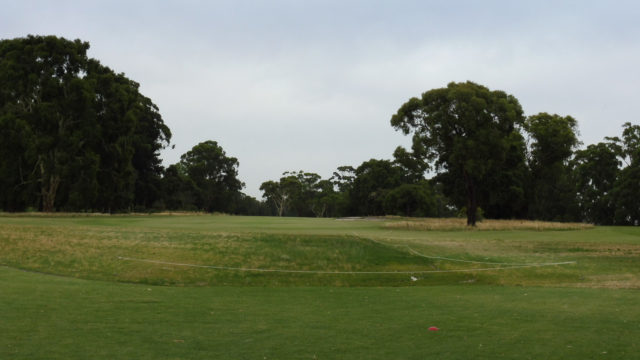
Hole 13 – 428 meter par 5
The tee for the shortest par 5 sits in one of the redesigned areas, which has seen tree clearing to the left. Playing relatively straight, the tee shot is required to carry a slight rise. I would have to say it felt like one of the more narrow fairway shots on the course, with native grass seen on the left and bunkers encroaching on the right.
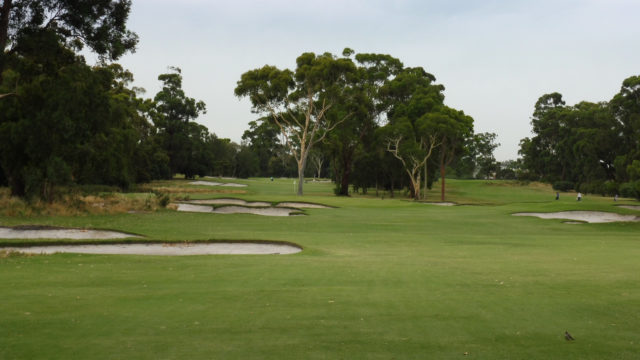
Approach to the 13th green
Keeping out of trouble from the tee, might allow the green to be reached in two, or at least leave it close. The ideal line in for most pin positions is the right side. One bunker is located just short of the green to add some risk to such a shot, although there is room short or beyond to stay safe. Playing long will see the ball feed away from the green down a slope. A hole which requires an accurate tee shot, but offers a lot of reward beyond that. Bunkers are well placed to catch out those not thinking the hole through properly.
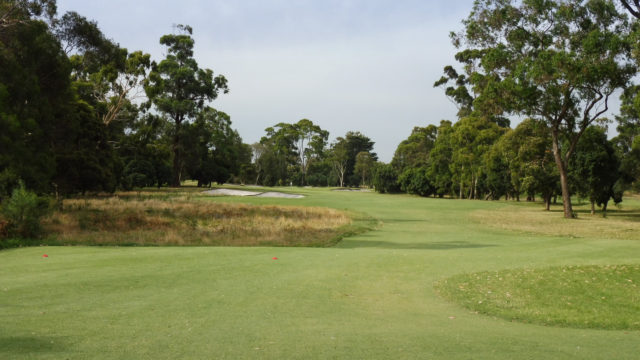
Hole 14 – 311 meter par 4
Heading in the same direction is this short par 4, playing relatively straight. The first fairway bunkers to the left should not come into play, although could be an issue for shorter hitters. A large area is available to land the ball beyond this before reaching another bunker on the left just over 210 meters out, where the fairway narrows. This side is the ideal line for the approach.
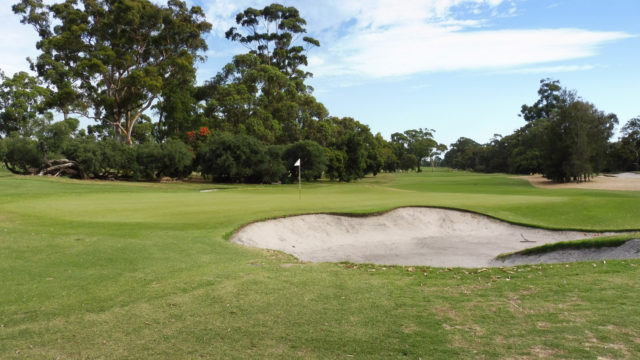
Looking back from 14th green
With a long green angling away to the right and bunker covering the middle, the best approach is made from the left of the fairway. A small slope is found at the start of the putting surface, requiring the ball to carry or run up beyond to make putting slightly easier. Another trap is located behind the green complex with some moderate sloping away found either side. A hole using some well placed elements (besides the first fairway bunker) which will reward or punish. These are used wisely to give a logical strategy to the hole.
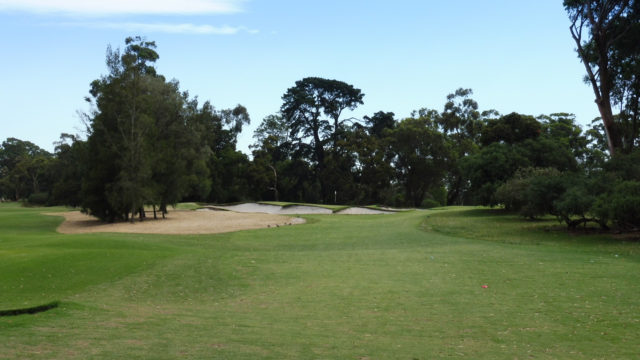
Hole 15 – 134 meter par 3
The last short hole on the course is a tricky shorter par 3. A forced carry is required to reach the green, with two large bunkers built into the sides of the green.
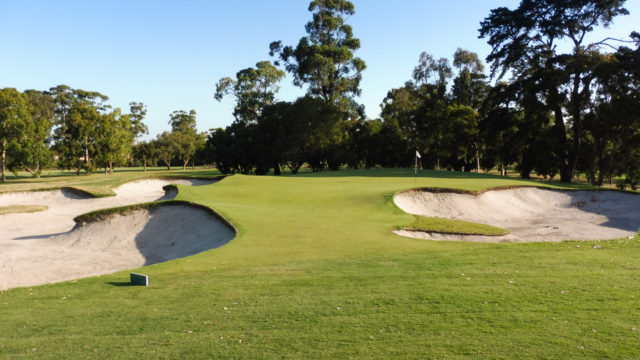
Heavily bunkered 15th green
The putting surface is longer than it is wide, making club selection more less important than direction. Some moderate slopes are found mainly from the rear to front. If the tee shot is long, this leaves a much more difficult recovery, than finding the sand. A nice hole, where the bunkers do their job, but I’m not the biggest fan of forced carries. I enjoy them but is not for all levels of golfer.
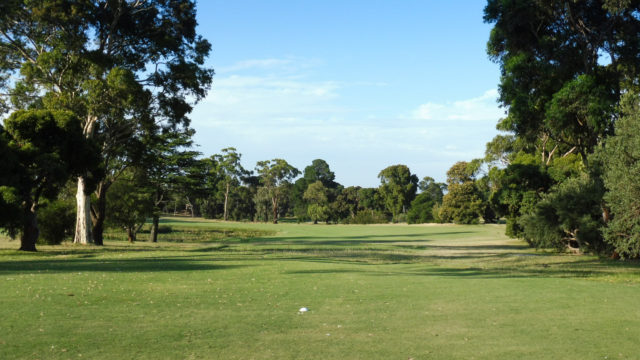
Hole 16 – 352 meter par 4
The last hole leading away from the clubhouse, is the medium length par 4. This plays around a water body, highly unusual on the sandbelt. Here you take on as much as you dare to shorten the approach, without getting wet. The ideal shot will stay left of the fairway. It is easy to drive through the fairway however bringing tree trouble into play.
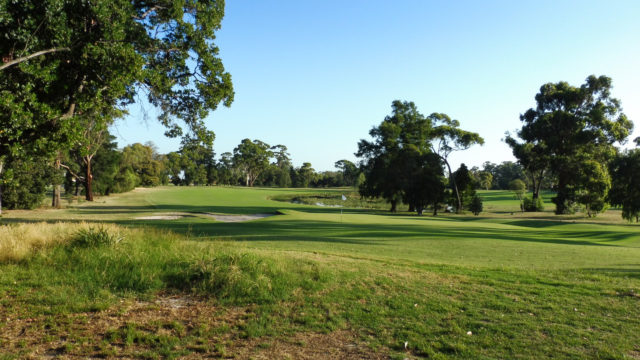
Looking back from the 16th green
A large bunker is located to the right of the green, whilst a shallow swale runs the left side, which is the easier side to recover for any miss. The putting surface slopes predominantly from the rear, although being a bit to close on the left side, could see the ball run into the swale. Great hole which offers risk vs reward not only from the tee, but also on the approach.
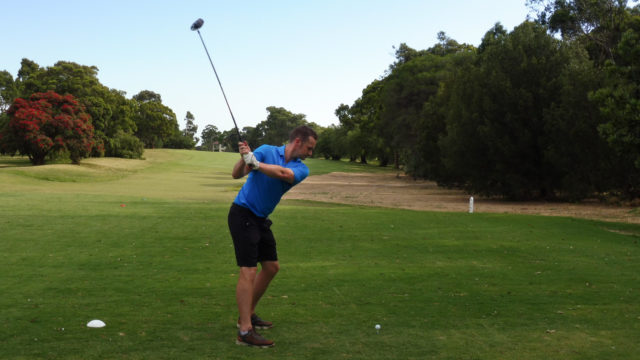
Hole 17 – 298 meter par 4 – Tim’s ball about to launch
The penultimate hole is a short par 4 playing over a hill with a blind shot. Trees run down parts of the fairway, but it is a large ti-tree at the end of the fairway left, which hides the green. The fairway slopes predominantly left to right, which should assist the ball going to the preferred side to make the approach shot.

Approach to the 17th green
A small bunker sits to the left of the green, which is narrow angling away to the left. The slope also runs left to right, making it almost an impossible shot to hold the green when approaching from the left. The right, but more the rear of the green have large slopes away, so should be avoided. This is not a ‘pretty’ hole. In fact aesthetically it is very basic, more around the green complex. But this doesn’t mean it is devoid of strategy or easy to play.
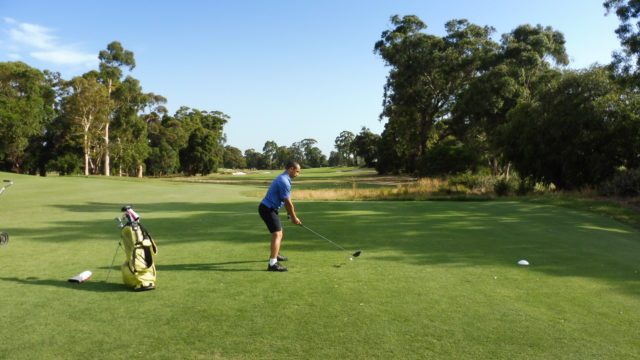
Hole 18 – 375 meter par 4 – Steven taking aim
To finish the round is the hardest hole and longest par 4 at Commonwealth Golf Club. Playing with a dogleg to the left, there is ample fairway to hit from the tee, but also lots of danger. A bunker to the right should not come into play as it can be easily carried, but the large complex on the inside of the turn needs to be avoided at all costs. This will leave a long bunker shot to reach the green from the best side of the fairway to make the approach.
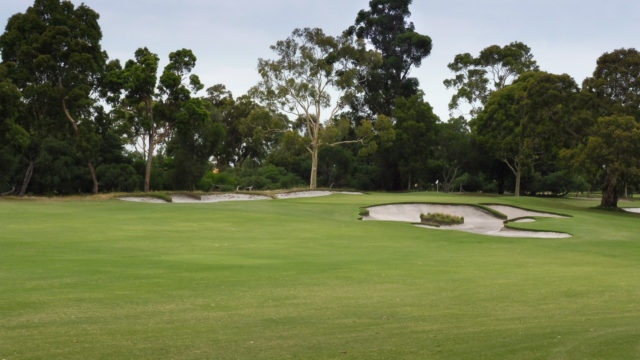
The 18th green from the practice area
A small opening is found to the left of the green, which has bunkering along its left, and a classic style bunker for the sandbelt, where an island in the middle is found. For those on the right of the fairway, this is a large target to carry. Good design which is fair for all levels of golfer with such a wide fairway, but still requires the correct lines to be played to make life easier. Nice finishing hole.
Looking at the course makeup:
- Hole Directions – There was a some variety allowing for conditions to have wide ranging effects during play. Surprisingly, well maybe not due to the parcel of land, a majority were north or south facing. Not one was in an east or west direction. One issue is the number of consecutive holes running in a similar direction. Numerous occurances where two holes did this
- Hole Lengths – Par three holes had a great variance in distance, with an even mixture from short to long. Par four holes ranged from short to long with a fairly even spread. Par 5 holes also ranged from short to long with the latter being the majority
- Hole Layout – There was a decent mixture in how the holes played, with a fairly even balance between turns to the left and right, where two shots or more were required to reach the green. These did however usually occur on consecutive holes as well
In summary I quite enjoyed the course. More so on the second visit that the first. This could be related to the changes that OCCM had implemented in between my two visits. After looking at the photos between the two, there was dramatic improvement. I just hope that this can continue further giving the members an even better course.
The condition was fair on my second visit. Due to some extreme heat grass had been let to grow out slightly on the fairways, which had some impact on the ball running. I was informed that a particular grass had be used also to reduce the amount of run. The greens were firm and had consistent roll, although slightly slower than expected.
One of the main issues is the number of trees encroaching around fairways and bunkers. There seems to be an obsession with them. They also seem to interfere with playing lines at times also. This is something that could easily be rectified.
The course was quite memorable, with most holes having good strategic merits, although there were a couple that didn’t fall into this category. But then what course is one hundred percent perfect? Certainly a course you would not hesitate to play again.
How to play at Commonwealth GC:
1. Be invited by a member
2. Be an interstate or overseas visitor who is a member of a golf club

